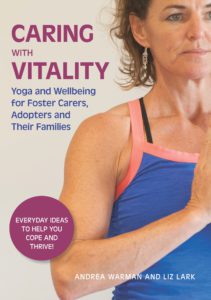 Young Royals Kate, William and Harry promoted the Heads Together charity earlier this week with a campaign encouraging people to talk about mental health and to find practical, everyday ways to help. During Foster Care Fortnight it seems fitting to think about the wellbeing of carers who risk becoming stressed, anxious or depressed. Yoga and other mind/body practices can help – and they don’t all require being super-fit or flexible. It all begins with good breathing, so try this simple exercise from our book Caring With Vitality – Yoga and Wellbeing for Foster Carers, Adopters and Their Families.
Young Royals Kate, William and Harry promoted the Heads Together charity earlier this week with a campaign encouraging people to talk about mental health and to find practical, everyday ways to help. During Foster Care Fortnight it seems fitting to think about the wellbeing of carers who risk becoming stressed, anxious or depressed. Yoga and other mind/body practices can help – and they don’t all require being super-fit or flexible. It all begins with good breathing, so try this simple exercise from our book Caring With Vitality – Yoga and Wellbeing for Foster Carers, Adopters and Their Families.
Breathing holds the key
‘If you breathe well, you will live long on the earth.’
Yoga is not just about the physical asanas (postures). In fact, it is learning and practising a different way to breathe that will revitalise you even more than doing the poses.
All too often we become used to taking quick, shallow breaths (into our chests rather than our bellies), without making full use of all our breathing muscles, or our full lung capacity. If we carry on with this ‘bad’ breathing, the result can be physical tension and a whole range of other health problems.
So it’s important to become aware of our breathing, and to return to a natural, deep way of breathing (like we do as children). which has both a healing and balancing effect.
The foster carers from our Teynham project told us that they found making this change helped to ground and calm them too, especially in times of stress as Marie explains:
‘I suppose you get used to shallow breathing and at first I found it hard to slow that down and breathe more deeply. It made me realise how anxious I have been all this time. How tight, how much tension I’ve been carrying around. But over the weeks I’ve felt myself relaxing. Accepting things. Letting go…’
Like Marie, you can try this exercise too. It’s called Three-Part Yogic Breathing. It encourages full, deep breathing and is the perfect way to start your process of de-stressing.
Three-Part Yogic Breathing
1. Lie down with your knees bent up and your feet hip-width apart on the floor. Place a folded blanket beneath your head if that feels comfortable, to encourage your neck to lengthen.
2. Rest your hands just below your navel. Now observe your breathing for ten full breaths, drawing each one deep into your belly. Feel your navel rise each time you inhale, and fall each time you exhale.
3. Rest your hands on your rib cage and observe your breathing again for ten breaths. As your lungs empty at the end of each exhalation, feel your middle fingers touch. As your lungs fill on each inhalation, feel your fingers separate. At the end of the tenth breath, aim to empty your lungs completely and feel your navel draw toward your spine.
4. Rest your hands across your collarbones, letting your elbows rest to the sides. As you inhale, feel your chest rise and your collarbones expand towards the side of the room. Become aware of fresh space between your shoulder blades. As you exhale, relax your chest, empty your lungs and feel your navel draw toward your spine.
5. Finally, practice the first three steps so that you breathe in all three portions of your torso: your belly, your rib cage and your collarbones. This is Three-Part Yogic Breathing. Try to keep each inhalation and exhalation of equal length. Follow the flow of the breath, imagining each one as a wave washing through you. Then feel how this steady, calm breathing makes your mind feel like a still, but powerful sea.
Once you have become used to this technique there are other exercises you can use, depending on the time of day, and how you are feeling.
‘Take the breath of a new dawn and make it part of you. It will give you strength.’
Click here to find out more about Caring With Vitality